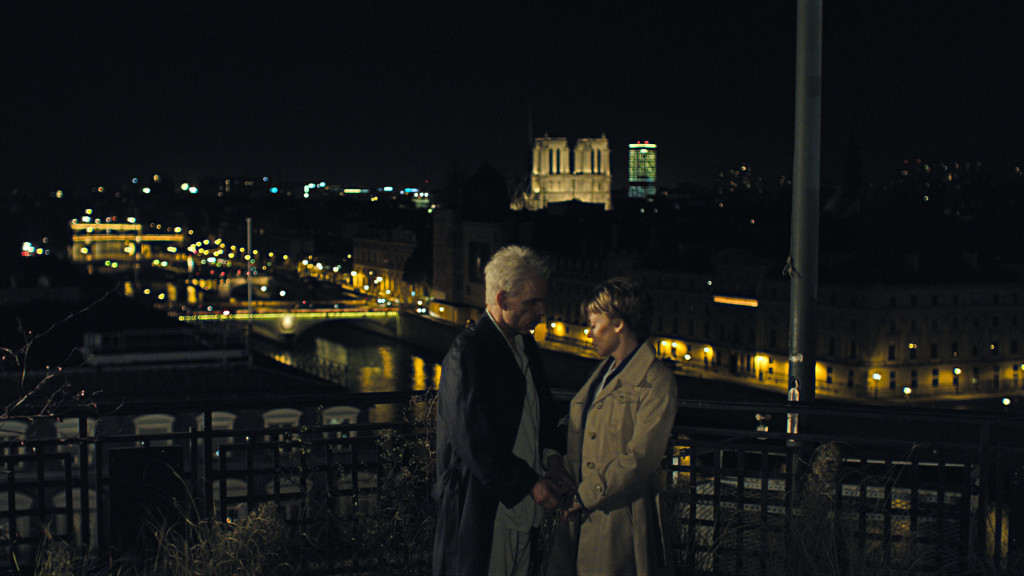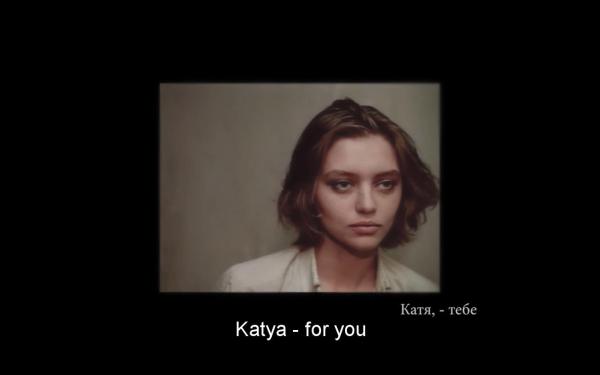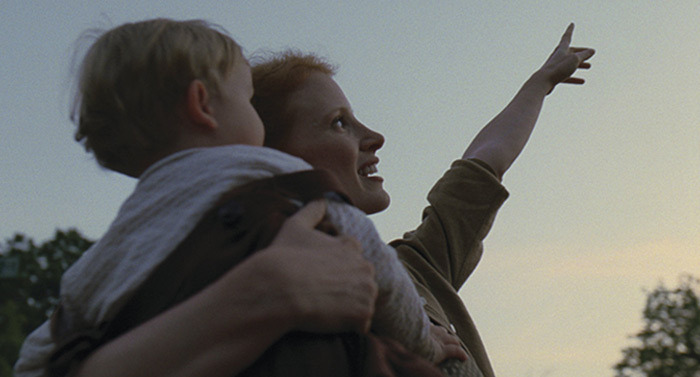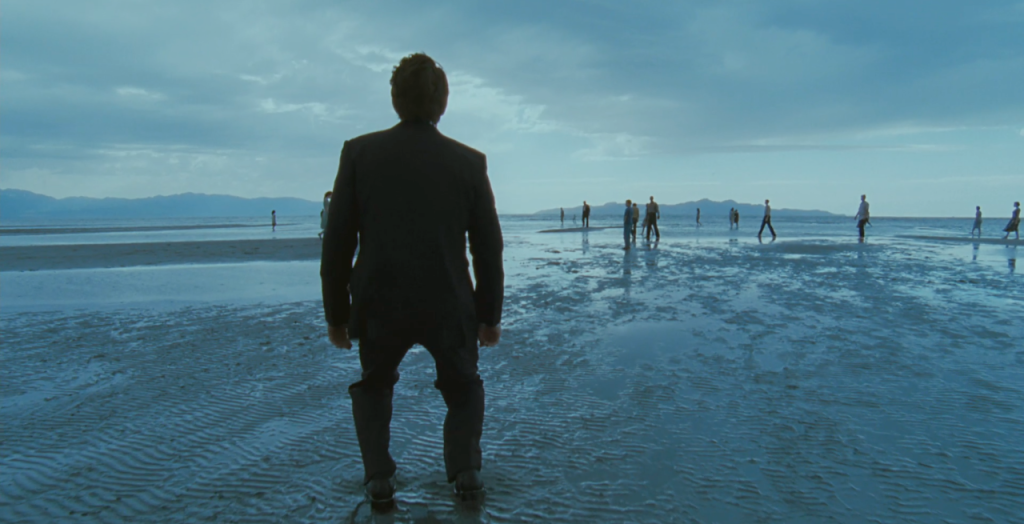It was interesting ending the previous segment with Synecdoche, New York, which ended in the author’s creation being led to ruin and despair, because a surprising amount of these authorial therapy films feature apocalypses or apocalyptic imagery to convey the emotional wreckage of their creators. And few cinematic apocalypses are as grand and operatic as Lars von Trier’s Melancholia, a film about a woman dealing with clinical depression during what’s meant to be the happiest moment of her life, and a massive planet on a crash course for earth.
Von Trier stated in interviews that the film was inspired by a bout of depression that he experienced during and after the production of his previous feature Antichrist. He went to his therapist for guidance during this episode, who explained that depressed persons tend to act more composed and placid during moments of heavy stress. This gave von Trier the idea for a film that placed a depressed character under the most stressful of situations: the end of the world.
The first act of the film has almost none of the disaster movie elements yet, as we witness Justine (Kirsten Dunst) unable to enjoy her own wedding day, despite being what should be the ultimate day of happiness. Her depression is so severe that it effectively ruins her marriage shortly after. Later, when the fated planet finally comes into view, Justine welcomes it with reckless abandon, even going so far as to remove all her clothes and just lie near a river, almost like she’s seducing it to come ever closer.
The inevitability reaches its peak when the planet finally reaches earth, and Justine teaches her sister Claire (Charlotte Gainsbourg) and Claire’s young son to embrace the despair, as they each hold hands during their incoming demise. As they partake in this solemn yet simple final embrace, Claire is the only one who breaks the hand-holding chain right as the planet is about to make impact, reduced to a nervous wreck just seconds before the world’s end. Interesting considering Claire was the happier main character at the beginning of the film. And yet, her spirit and will to live is torn even more than Justine.
Melancholia‘s ultimate “message” is both startlingly bleak and a clear product of its creator’s psyche. While depression is the gateway to despair, it also allows one to see the world in a different way, sometimes finding beauty in the most horrifying of circumstances; whereas the most happy of people have a major flaw: they have everything to lose. Like Justine, von Trier makes peace with his own despair by allowing Melancholia to crash through him, thus allowing him to see something most filmmakers would rarely explore. For he has nothing to lose.
But sometimes, using cinema to diagnose psychological problems is not enough. Sometimes, there are moments in the past that simply can’t be forgiven, actions that can’t be taken back, and tragedies that are permanently etched in time, unable to be erased. This is where the concept of cinema as authorial therapy really takes shape, as filmmakers use the medium as a means of not just reconciling with their emotional and psychological state, but with very specific moments from their own past.
One of those films is Darren Aronofsky’s The Fountain, one of the most underappreciated and masterful films of the 2000s, not only because it’s a breathtakingly beautiful film visually and emotionally, but also in how it breaks apart the very essence of the author’s own grief. The film depicts three stories of varying genres and time periods featuring the same duo of actors, Hugh Jackman and Rachel Weisz, and ties them all together through a non-linear structure (a clear inspiration for the similarly made Cloud Atlas).
In the 1500s, a Spanish Conquistador named Tomas (Hugh Jackman) must find the fabled Tree of Life to save the Queen of Spain (Rachel Weisz) from the Inquisition. Around 500 years later, a doctor named Tommy struggles to find a cure for his wife’s cancer, both of whom are played by the same actors. And in the far distant future, an astronaut in a space-biosphere named Tom holds a dying Tree of Life, bringing it to a distant nebula that can hopefully resurrect its power.
The idea was developed by Aronofsky and co-writer Ari Handel when they were roommates in the same university, thought of more as a romantic epic back in the day. But the story truly came into fruition when not one but both of Aronofsky’s parents were diagnosed with cancer. At that moment, he saw a visible countdown to zero looming over the people he loved, and through that, an early grieving process began. It was at that moment that Aronofsky’s story suddenly evolved into something more melancholy and intimate instead of epic and exciting.
The main story which the audience most relates to (and has the most screentime) is that of Tommy attempting to cure his wife’s cancer, which is already an interesting parallel to Aronofsky’s own grieving process (and the casting of Weisz, Aronofsky’s girlfriend at the time, makes it feel all the more personal). The other two stories however, the Conquistador and the Astronaut, waver in authenticity. Are these events actually occurring in the film’s world? Is it the product of Izzy’s dying imagination as she writes a novel on her deathbed? The result of Tommy’s grieving imagination, as he fails to accept his wife’s fate?
There are numerous interpretations regarding the authenticity of each story, but the question remains why Aronofsky bothered having the past and future stories when just the present-day one was enough. Sure, it makes the film more interesting and original, but it also further depicts the struggle between life and death as something truly universal: an eternal struggle stretching beyond time so long as the human will to live exists. Tommy learns the effects of being unable to accept death through both stories—which act as personifications of his own grief. The Conquistador is punished to “eternal life” by being transformed into a bed of flowers right beside the Tree of Life, thus failing and succeeding his mission. The Astronaut, on the other hand, embraces death after having lived hundreds of years in his secluded space-bubble, and is freed of his despair.
In the end, life is utterly worthless without an ending. Eternal life is a sham, and the ones who refuse to accept, embrace, and reconcile with death are the ones that will never truly be happy. The Conquistador went one way, the astronaut went another, and it is our Tommy who sees both sides of the eternal struggle. I wrote more in length on the film in this article, but suffice it to say, it remains one of the most harrowing, original, and beautiful statements on the grieving process in cinema, and part of that is what Aronofsky’s own grief brought to the film.
Yet as fascinatingly personal as The Fountain was, the film’s themes were treated in a very intentionally general manner, which complemented its theme of the universality of the struggle between grief and death. And while that may have been enough for Aronofsky to cope with his existential crisis, it isn’t for other people. Sometimes, authors have to dig even deeper, taking a more Fellini-esque approach by nearly recreating the past in order to make peace with it.
A very recent film, Leos Carax’s Holy Motors, does this heartrendingly. At first glance, the film is a surrealist series of vignettes revolving around a mysterious man known only as Monsieur Oscar (Denis Lavant) who is driven from appointment to appointment via limo (driven by a chauffeur played by Edith Scob), and adopting the roles of numerous characters for mysterious purposes, as no cameras can be seen filming his various personas. Does this take place in the world of film, the mind of Leos Carax (who appears in the film’s prologue), or is something more bizarre at play? Perhaps it’s a bit of everything, with something both troubling and romantic added in.
Many view the film as a celebration of the diversity and power of cinema, as Monsieur Oscar embodies multiple genres, characters, and well-loved stories all within the course of 24 hours. But another interpretation calls out parallels to Leos Carax’s life. To keep a long story short: the woman of Carax’s life and the mother of his child, Russian actress Yekaterina Golubeva, tragically died in August 2011, right before the film went into production. While nobody knows for sure what the cause of her death is, Holy Motors makes peace with that tragedy in a very interesting way, implying that it may have even been a suicide.
Monsieur Oscar’s profession of sorts could be seen as a parallel of Carax’s own life as a filmmaker, as Oscar is ostensibly creating stories and cinematic experiences out of the everyday world around him. But when the film has to deal with Carax’s tragedy, the death of his lover, it does so in an absolutely heartbreaking scene.
After a series of appointments, Oscar meets a fellow woman with the same occupation as him (Kylie Minogue). The two have a history together. During their tearful farewell, depicted in the form of a musical number, it’s implied that she bore his child and is forced to be with another man, as part of her appointment, which recalls Golubeva’s apparent history with other men before Carax. Their brief and final encounter culminates with him leaving her to “finish her appointment”, only to find that in doing so she’s jumped to her death.
Holy Motors becomes a celebration not only of cinema’s diversity, authenticity, and outlandishness but also of its power to heal emotional wounds. Monsieur Oscar is a character who literally lives for film, in much the same way that Carax lives for. It is what gives his life purpose. But what’s all the more heartbreaking about this is how Oscar’s appointments recall Golubeva as well, who is also an actress, embodying all sorts of different characters and lives throughout her career. In that sense, the film is also a tribute to the power of the actor, and thus a tribute to this woman.
Regardless of who Monsieur Oscar really represents, Carax and Golubeva share one thing that bonds them: a love for cinema, and the strange and beautiful things they’re able to do in that playground that frees them both, even beyond death.
When it comes to Cinema as Authorial Therapy, no list is complete without Terrence Malick’s The Tree of Life (which I’ve also written in-length about in another article). It’s a film that combines the therapeutic elements from both The Fountain and Holy Motors—a rich tapestry detailing the universal struggle between life and death throughout the history of the universe, while also being a deeply intimate autobiographical retelling of Malick’s upbringing in 1950s Texas.
At the center of it all is Jack O’Brien (Sean Penn), who serves as Malick’s avatar, looking back at both the origins of the cosmos and his own origins in Waco, Texas, then looking for the things that connect him to the DNA of his universe. He sees the way in which the stars are crafted, how the sea forms land on the earth, and how life begins to evolve from the single-cell organisms, and so on.
Following directly after this is Jack’s rumination of his childhood, which takes up the majority of the film, as he’s raised by a mother representing the Way of Grace (Jessica Chastain) and a father representing the Way of Nature (Brad Pitt), and lives with two younger brothers named Steve and R.L. Giving these scenes a mournful sense of longing is the film’s introduction, where we learn that one of the two brothers died, though it’s barely implied which one died or how it happened.
This gives the flashbacks a purposeful context, as Jack, still depressed as an adult, looks back to his childhood and traces back to the origins both his and the universe’s innocence. Similar to Aronofsky and The Fountain, The Tree of Life calls for a life defined not by despair , but of affection and acceptance. But there is something far more personal under the surface of the film.
The setting isn’t the only thing taken out of Malick’s own childhood. Terrence also had two younger brothers, named Chris and Larry. His father, Emil, was a geologist, a literal Man of Nature. Larry was the more musically gifted brother, playing the guitar (a prominently featured instrument in the film) and going off to a special music school in Spain when he was older. However, this ultimately proved to be the instigator of the tragedy. Detailed in the novel Easy Riders, Raging Bulls, Larry had been pressured so much from his musical studies that he exhibited suicidal tendencies, breaking his own hands. His father Emil tried going to Spain to see how he could help, but by the time he showed up, Larry was already dead, supposedly by suicide.
Malick’s regret and sadness for that moment seeps through every frame of The Tree of Life. You could see how one would wish to go back to those halcyon days of being able to run around the empty suburban streets, blissfully unaware that their innocence will die before they do. It’s nostalgia filmmaking of the highest order, but with such a tender care and personal touch throughout that makes it emotionally arresting.
That is, until the film’s final ten minutes kick in, creating one of the most heavy hits to the heart I’ve ever had in a theater. Like Fellini’s conclusion to 8 ½, Malick brings back all the people from his life to commune in loving embrace, with Jack O’Brien finally making peace with each one. But there are a couple of key differences in how Malick handles this scene compared to Fellini.
The first is its religious, metaphysical undertones. Whereas Guido was very obviously imagining his parade as part of an elaborate daydream, Jack’s experience with his family, friends, and younger selves may very well take place in his mind, but they may also be some spiritual awakening taking place somewhere between time, space, and death. Some even say the final moments of the film are actually Malick’s take on a Rapture-like Apocalypse.
But the main thing that differentiates The Tree of Life from 8 ½, and it’s what makes this scene such a heartbreaking, tear-jerking moment, is that Malick isn’t simply providing a chance for himself to reconcile with his past. He takes it a step further by also bringing closure to many of the other characters representing his childhood. His neighbor who was burned in a fire is able to walk out in public with the others again, Mrs. O’Brien plays with her children once more, and so on.
But most importantly and heartbreakingly of all, we see Mr. O’Brien simply carrying one of his younger sons, presumably the one who died, and having one last moment of peace with him—coinciding with Emil Malick’s failure to be with Larry right before his death. Real life may have been unfair, but the cinema could give a glimpse into another life where they were given a second chance. Terrence moves on from his past by assuming the role of god in his own life, like Guido directing his past like a circus ringleader. Rather than seeing himself as one piece in a vast, limitless universe, he decides to recreate it through cinema, and take control of his own grief, retconning the fates of himself and his family through the final ten minutes.
And the film truly was an important development for Malick. While all of his films prior to this were separated by long gaps between release, The Tree of Life clearly brought something out of his system, as he started production on four other films, including this year’s To the Wonder, one after the other. Whatever the film means to viewers, it’s clear that it meant the most to Malick, and the results from his new production habits are crystal clear.
[youtube http://www.youtube.com/watch?v=gFEuLx9OIvY]
In the next and final article, it all comes tumbling down, tumbling down, tumbling down.


























